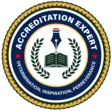
Explore how innovative, data-driven assessment strategies, from curriculum mapping to competency-based evaluation,empower universities to improve learning, retention, and institutional performance. Learn actionable best practices and how Accreditation Expert Consulting can support your growth journey.
In today’s evolving higher education landscape, traditional metrics, such as grades, retention rates, and graduation numbers, no longer suffice. Modern leadership demands smarter, more meaningful assessment tools that produce real-time insight and drive institutional growth.
This article, drawing on deep experience from Dr. Ramin Golbaghi and Accreditation Expert Consulting, explores the shift from basic assessment to strategic, data-driven evaluation within universities. We’ll highlight why smarter assessments matter, how they can be implemented, and the impact on quality, compliance, and student success.
Why Smarter Assessment Is No Longer Optional for University Growth

In today’s environment, university growth isn’t just about enrollment; it’s about credibility. And credibility starts with how you measure learning.
For decades, institutions have leaned on traditional metrics like course completion, credit hours, and pass/fail rates. But the students walking through our doors today, whether physically or online, aren’t looking for checkboxes. They’re looking for value. They want clear outcomes, relevant skills, and a return on investment they can explain to their families, their employers, and themselves.
This is where smarter assessment comes in.
Not as a report we file at the end of the year. Not as a compliance exercise, we rush through for an accreditor. But as a strategic tool that gives us real answers to critical questions:
- Are students actually learning what we say we teach?
- Are our programs aligned with the needs of the workforce?
- Can we confidently demonstrate that our graduates are well-prepared for their next steps?
When institutions commit to data-informed assessment, they gain more than dashboards. They gain visibility. Into what’s working. What’s missing? And what needs to change, not five years from now, but in the next curriculum cycle.
This is about building a university that knows itself. One that can speak with confidence to its students, its board, and its accreditors, not in slogans, but in outcomes.
If your institution is planning for growth, retention, new program launches, or reaccreditation (reaffirmation), this is the conversation that must come first.
Smarter assessment isn’t a side project. It’s your foundation.
From Grades to Insight: Building a Curriculum Mapping Strategy That Drives Learning
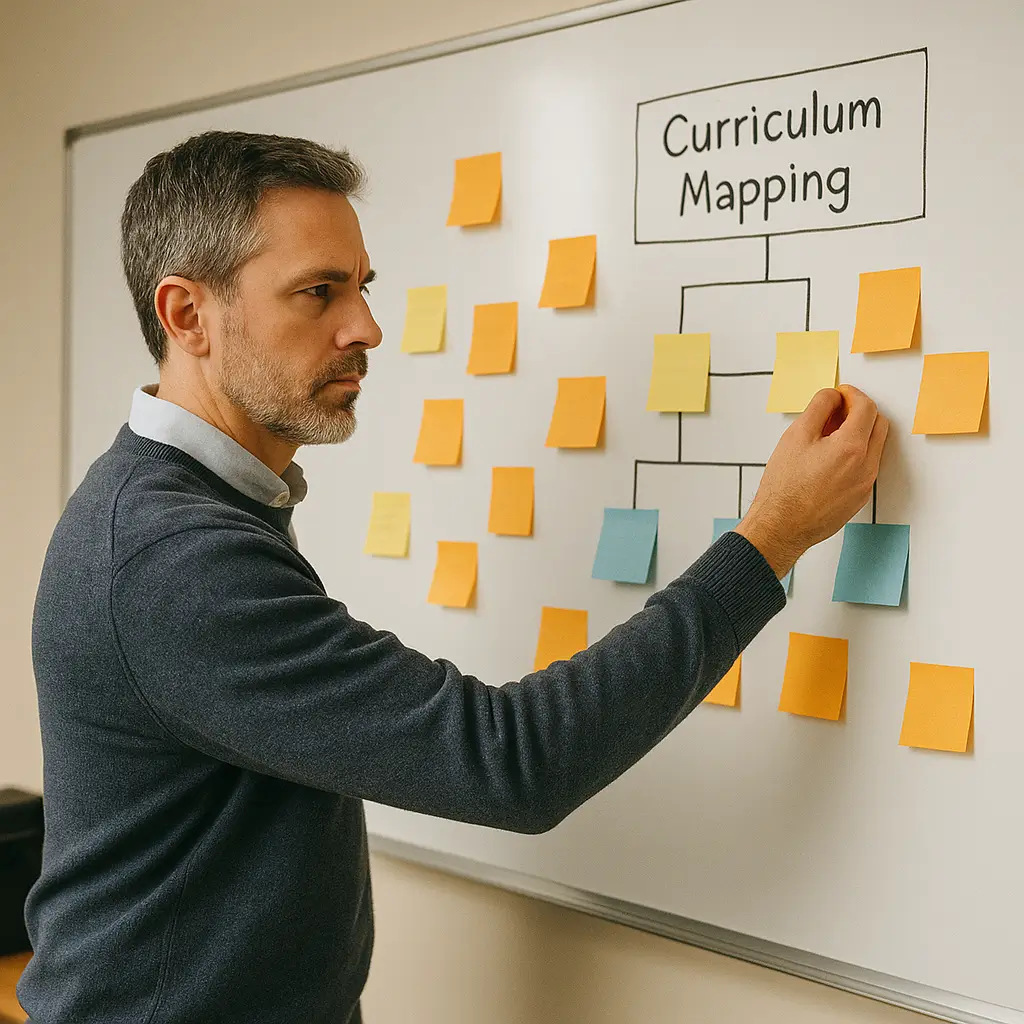
Grades may tell you who passed. Curriculum mapping tells you why.
If your institution is serious about improving outcomes, not just reporting them, then curriculum mapping must evolve from a back-office checklist into a front-line planning tool. This isn’t just about accreditation readiness; it’s about academic coherence. Done right, curriculum mapping aligns every piece of your instructional design, course content, learning objectives, assessments, and outcomes into one clear, measurable framework.
At its core, this process answers questions leaders ask every day but rarely get full visibility on:
- Are students mastering the competencies our programs promise?
- Are we unintentionally teaching the same skill in three different courses—or worse, skipping one entirely?
- Do our assessments actually match what faculty are teaching and what employers expect?
True curriculum mapping doesn’t rely on templates. It begins with faculty ownership and program-level competencies, not just course titles. From there, institutions can trace how those competencies appear in syllabi, assignments, and evaluations. Gaps become visible. Redundancies surface. And that’s where growth begins.
Here’s what it takes to get it right:
- Start with end goals. Define what each graduate should know and be able to do. Then work backward.
- Use faculty-designed rubrics. Standardized, department-approved rubrics eliminate grading inconsistencies and focus attention on meaningful learning, not just test performance.
- Balance formative and summative tools. Weekly reflections, projects, and capstones all have a place. Don’t wait until finals week to measure understanding.
- Bring in employer and licensure alignment. For career-focused programs, such as nursing, IT, and business, ensure that every assessment is linked to a real-world competency.
Executive Insight:
A strong example comes from a nursing school that used mapping to align simulations with critical care competencies required for licensure. Within two terms, the program not only improved NCLEX pass rates but also reallocated clinical hours more effectively based on student performance data.
Curriculum mapping doesn’t just improve instruction. It builds confidencein your programs, faculty, and the promises you make to students and accreditors.
Real-Time Feedback Isn’t Optional, Why Mid-Course Check-Ins and Analytics Are Reshaping Instructional Impact
Too often, we treat feedback as a postmortem, useful only after the learning is done. But if the goal is continuous improvement, then waiting for end-of-course evaluations is too late and too passive. Students have moved on. Instructors are already planning their next syllabus. And the opportunity for timely course correction is lost.
That’s where real-time feedback mechanisms come in: short, structured, and immediate tools that allow institutions to see how learning is unfolding as it happens. These aren’t just student satisfaction measures; they’re a direct lens into instructional alignment and cognitive engagement.
Why this matters now
Higher education is shifting toward student-centered learningand data-informed strategy. Yet many campuses still rely on outdated instruments that capture opinions, not insight. Mid-course interventions change that. They give your faculty and your leadership something rare: the chance to act before disengagement, withdrawal, or failure occurs.

Proven strategies your institution can implement now
- Pulse Surveys via LMS
One-minute, anonymous check-ins asking students what’s working and what’s confusing. Done weekly or biweekly, these surface issues you can’t see in analytics alone—unclear instructions, off-track discussions, or concept fatigue. - Course Analytics Dashboards
Most LMS platforms already capture valuable data, including log-ins, page views, and assignment completions. The key is not collecting more, but making the data usable. Flag engagement drop-offs by module or week. Spot where students are stalling. - Facilitated Reflection Sessions
Run 20-minute focus groups mid-semester with faculty or instructional designers. What students say in a guided format often reveals more than survey data. This is especially effective in hybrid and adult-learner environments where nuance matters. - Action + Accountability
Feedback is only useful if it leads to a change. Faculty should receive support—not just reports—to adjust pacing, add scaffolding, or clarify learning objectives. And leadership should document how feedback loops are driving actual improvements.
Executive Insight
One university piloted weekly LMS-based pulse surveys in 12 general education courses. Within six weeks, instructors identified two high-friction assignments, clarified confusing rubric criteria, and adjusted pacing. Student comprehension, as measured by quiz scores and written reflections, improved by 17%. Course satisfaction scores rose by 24%. Most importantly, DFW rates dropped by 11%across the pilot group.
This wasn’t a tech upgrade; it was a mindset shift. Real-time feedback is a leadership tool, not just a teaching technique.
Equal Doesn’t Mean Identical, How Smarter Assessment Ensures Parity Between Face-to-Face and Online Learning

The question isn’t whether online learning can work; it’s whether it delivers the same quality of outcomes as face-to-face instruction. For institutions offering dual modalities, this isn’t a philosophical issue; it’s an accreditation, funding, and reputation issue. And it’s one that smarter assessment strategies are uniquely positioned to answer.
For years, universities defaulted to content parity: identical syllabi, shared textbooks, and similar assignments. But content alone doesn’t create equity. What matters is whether students in both settings are achieving the same learning outcomes, and that requires intentional, data-informed assessment design.
What Executive Leaders Should Prioritize:
- Common Rubrics, Not Just Common Content
Faculty teaching online and in-person sections must anchor grading to the same rubric. Without this, comparisons are at best anecdotal and at worst inequitable. Smart institutions develop rubrics collaboratively, then cross-train instructors to apply them consistently. - Modality-Specific Learning Artifacts
A reflection paper might work well in person; however, an online student might better demonstrate mastery through a recorded response or a portfolio piece. Both can align with the same CLO (course learning outcome) if the assessment is designed with intent. - Comparative Achievement Data
Use dashboards to compare outcomes across modalities. Where are online students underperforming? Are in-person students missing key skills? Disaggregate by demographic when possible. This isn’t about finger-pointing, it’s about finding where support is needed most. - Continuous Faculty Collaboration
Build communities of practice among instructors teaching the same course in both formats. These aren’t compliance meetings; they’re spaces to reflect on pedagogy, share assessment adjustments, and flag equity concerns early.
Strategic Insight
One institution analyzed assessment results from 16 core curriculum courses, which were offered both online and in-person. After aligning rubrics and calibrating grading across sections, they discovered that online learners outperformed face-to-face peers in digital communication and critical thinking, while struggling more with research-based writing. This prompted a new initiative for embedded writing support across both modalities.
smarter assessments in higher education
The result? Within two terms, writing-based assessment scores improved by 14% online and 7% in-person. That’s not just assessment, it’s strategic growth through evidence-based leadership.
From Clock Hours to Competency: Rethinking Assessment in a Skills-Based Era
For decades, the Carnegie Unit has defined academic value by seat time, 45 hours of student engagement per credit hour. While this model still dominates accreditation frameworks and financial aid formulas, it’s increasingly at odds with how modern students learn and how employers evaluate graduates. Enter Competency-Based Education (CBE), a shift not in theory, but in operational reality for institutions trying to stay relevant.
At its core, CBE rewards mastery, not minutes. It’s outcome-driven, personalized, and aligned with workforce expectations. However, transitioning from credit-hour benchmarks to competency-based benchmarks necessitates a nuanced recalibration of assessment design, instructional roles, and institutional infrastructure.
Key Implications for Higher Education Leaders:
- Define Competencies That Matter
CBE doesn’t mean looser standards, it demands more rigor in defining exactly what students must know and be able to do. Faculty must co-develop granular competencies that tie directly to job functions, licensure requirements, or advanced academic performance. - Redesign Rubrics for Mastery, Not Grades
Traditional grading curves don’t apply in CBE. Students either demonstrate proficiency or they don’t; there’s no partial credit for time spent. That means creating rubrics that distinguish mastery from mediocrity, with clear evidence criteria and performance thresholds. - Align Assessment with Workforce-Ready Artifacts
In CBE, assessments often look different: skills checklists, simulations, field evaluations, portfolios, externship logs, or client deliverables.These are not just proof of learning, they’re pre-employment credentials in themselves. - Manage the Credit Hour Conversion
While CBE challenges the credit-hour model, most schools still need to translate competencies into equivalent units to comply with financial aid, transferability, or regulatory reporting. Smart systems don’t abolish the credit hour; they overlay it with outcome-based progress tracking. - Support Faculty as Evaluators, Not Just Instructors
CBE faculty shift from content delivery to learning facilitation and performance evaluation. That requires training in performance-based assessment, calibration across assessors, and continuous improvement processes.
Strategic Note:
One AEC client, a nonprofit university serving adult learners, launched a CBE track in cybersecurity. They identified 22 core competencies aligned to NIST standards, built assessments around real-world project scenarios, and offered flexible pacing. Within two years, job placement rates increased by 19%, and employer satisfaction scores with graduates’ “job readiness” jumped from 74% to 92%.
That’s what happens when assessment becomes transformation, when we move from measuring time spent to measuring value created.
Assessment as Institutional Strategy & Compliance
Smarter assessment isn’t just a teaching tool; it’s a strategic pillar:
- Annual program reviews feed into institutional planning, budget, and staffing
- Data informs decisions on program viability, resource allocation, facility needs, and admissions standards
- Used by accrediting bodies like CHEA and DEAC, it underpins compliance and enhances reputation.
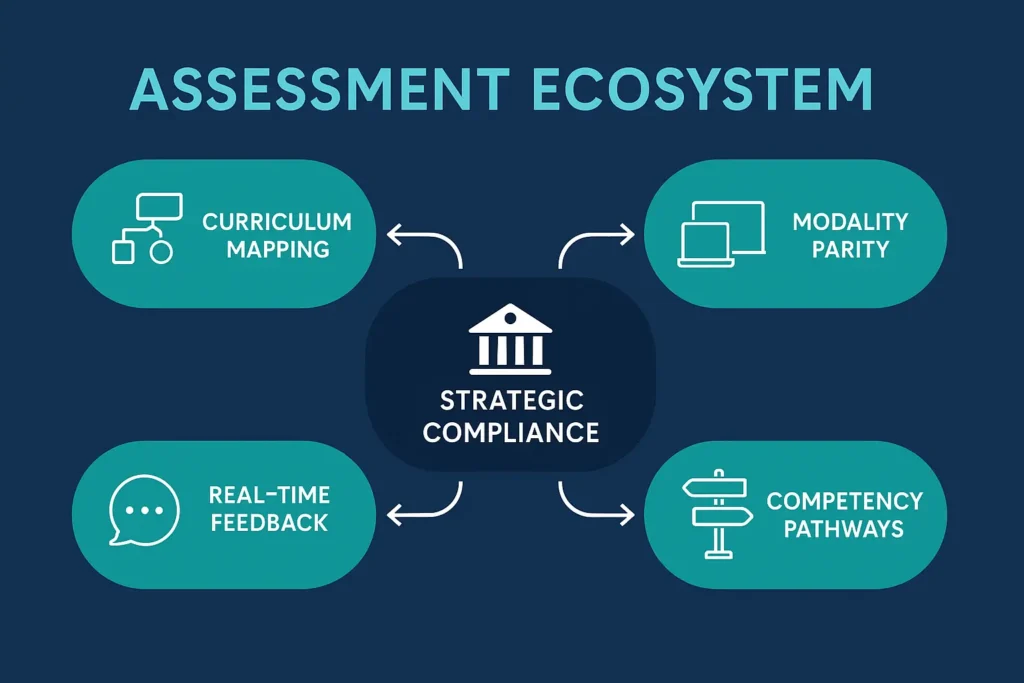
Figure: The Assessment Ecosystem linking instruction, data, and institutional compliance
Infographic created by Accreditation Expert Consulting | AccreditationXpert.com
© 2025 Accreditation Expert Consulting. All rights reserved
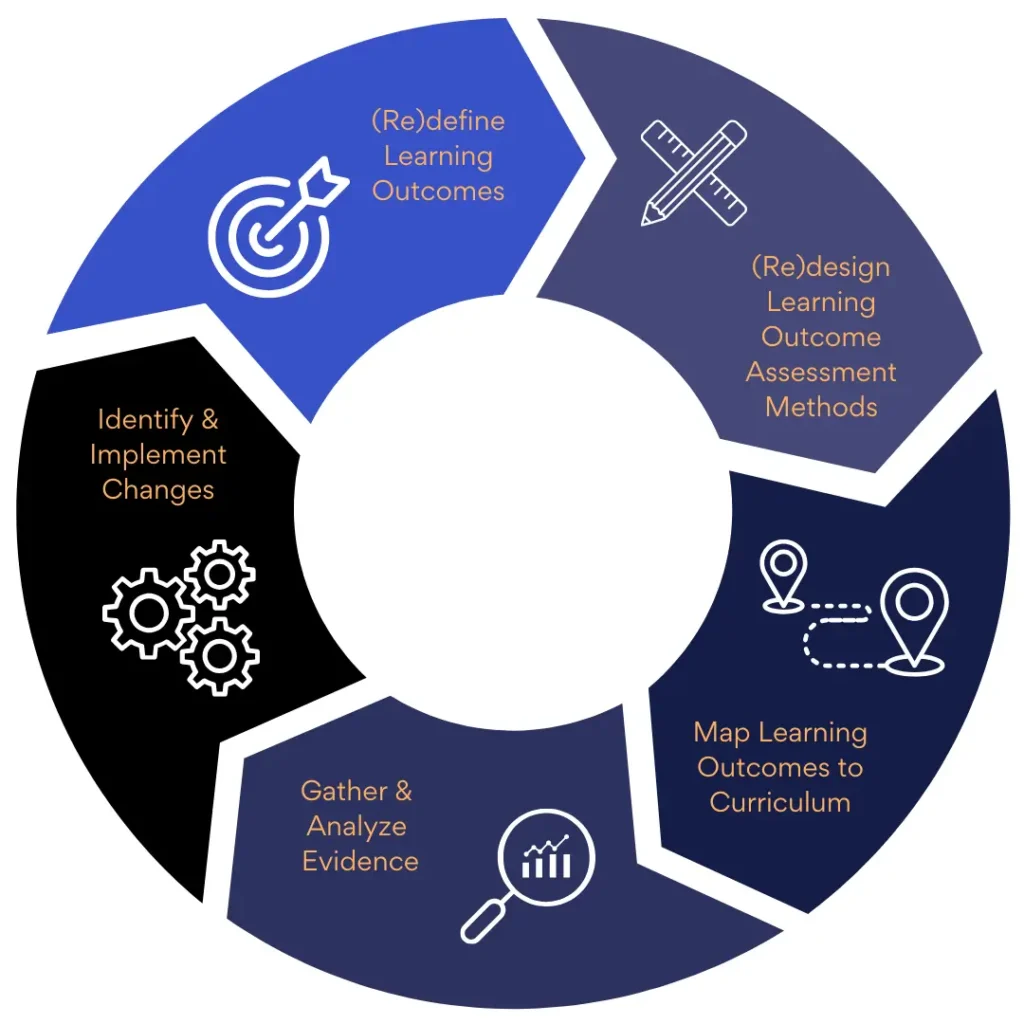
Figure: The Institutional Learning Assessment Cycle
Infographic created by Accreditation Expert Consulting | AccreditationXpert.com
© 2025 Accreditation Expert Consulting. All rights reserved.
Five Steps to Launch Smarter Assessment at Your Institution
- Map your curriculum to ensure alignment between program goals and classroom delivery.
- Implement mid-course checks for fast, actionable feedback
- Standardize evaluation tools across modalities (F2F vs. online)
- Define competencies, rubrics, and mastery criteria for both credit and CBE paths
- Integrate assessment data with institutional strategy and compliance cycles
FAQ
What’s the difference between formative and summative assessments?
Formative assessments provide ongoing feedback throughout a course, while summative assessments evaluate mastery at the end.
Do CBE programs qualify for federal aid?
Yes, if they comply with 34 CFR 668.10 and have defined credit equivalencies.
How often should an institution update its curriculum map?
Ideally, every academic year, or whenever program learning outcomes change.
Can small institutions manage this assessment strategy?
Absolutely, start small with one program and scale based on results; systems like LMS pulse checks can help.
Conclusion & Call to Action
Smarter, data-informed assessmentsare transforming higher education, from the classroom to the boardroom. They drive learning, support institutional reputation, and meet accreditation expectations.
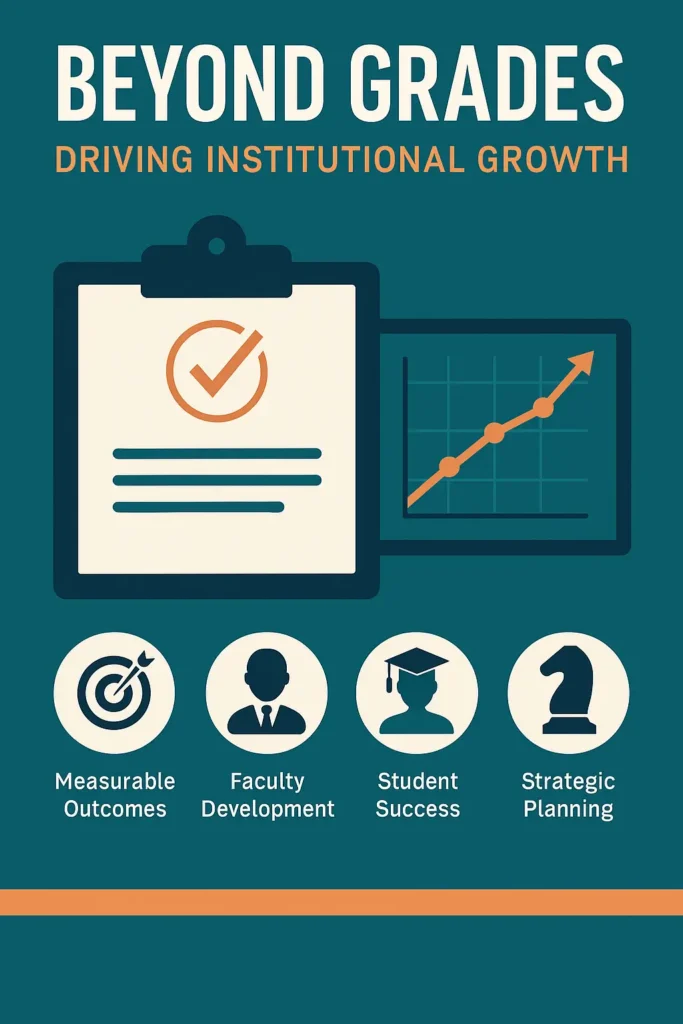
Figure: Beyond Grades – Driving Institutional Growth.
Infographic created by Accreditation Expert Consulting | AccreditationXpert.com
© 2025 Accreditation Expert Consulting. All rights reserved.
Ready to move beyond grades and rebuild your university’s growth strategy?
Visit Accreditation Expert Consulting to schedule a consultation, explore our accreditation and enrollment services, or download our Beyond Grades Assessment Toolkit for practical strategies you can apply today.
Content updated July 2025 • Written by Dr. Ramin Golbaghi, CEO, and Co-author Sam Askari, COO of Accreditation Expert Consulting.

